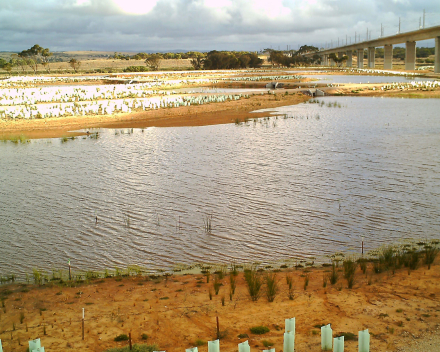- Home
- Australian Wildlife Moves In
Australian Wildlife Moves In
27/12/2018 - 00:00
Nested in one of the Onkaparinga River’s final bends before it empties out into Gulf St Vincent in Southern Australia, a decommissioned sewerage plant offered up a surprising amount of potential.
The site, part of an existing coastal wetlands setting is close to the growing suburb of Noarlunga Downs. Any remedial works here would mean local residents would suddenly have three hectares of new public open space to walk through. The views would certainly improve, and the amount of wildlife that was expected to move back in would be impressive.
Jamie Horne, the Environmental Services Manager of LCS Landscapes, the firm that planted the space, is genuinely amazed at how quickly the wildlife, as he puts it, ‘set up camp’. It was a case of if you build it they will come.
In the last-century sewerage treatment usually ended in ponds where the remaining sludge was allowed to settle and dry out before recycling. In the case of the plant at Christies Beach, the series of ponds sat together with a wide track around them. Turning this bleak vision into something vista-worthy was tricky, but a solution was reached with the clever use of earthworks and plants. The old tracks were retained for foot traffic, but the ponds were reworked to soften the old boundaries and to create promontories and islands. A gentle hill rises to one side with a new track to its summit from where there is now a view across the newly re-worked ponds and the winding river towards the sea.
The plant species list and zoning plan was meticulously put together by SA Water and three local propagators and growers were commissioned to produce the 187,000 local provenance plants. It was then up to Jamie Horne and his team to get these into both the terrestrial and aquatic sections of the project.
“We had 10 people on the team which started planting in August 2013, finishing in October. All of the plants that went into soil were planted with TerraCottem, and I’d put the success rate conservatively at 95 per cent. The decision was made not to use mulch – the look we were aiming to achieve was to be as natural as possible – and this did contribute to the soil drying out very quickly."
“It is still early days, but the transformation is taking place. The gentle hill is covering itself in sections of shrubland and open woodland. And the same transformation is taking place around the ponds – which are looking more like lakes – and are rimmed by the riparian plantings. But it’s the aquatic species, plugged into the bottom of the ponds with Hamilton tree planters, which have probably made the biggest biodiversity impact. And the biggest change is the arrival of the birds from Fairy Wrens to Pelicans, they have all taken up residence.”
| Attachment | Size |
|---|---|
| 1.77 MB |
In 2018 we celebrated our 25th anniversary... in 2023 TerraCottem exists 30 years...
For all your questions regarding TerraCottem soil conditioning technology
Yours for askingFor all your questions regarding TerraCottem soil conditioning technology
Yours for askingTerraCottem Intl. SL
Apartado de Correos 4511190 Benalup (Cádiz)Spain



